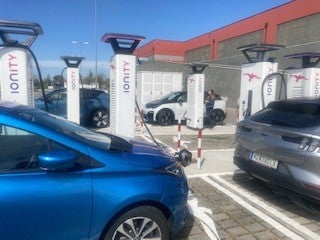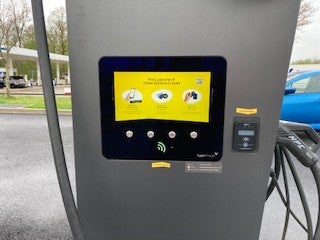
Last year I drove my Renault Zoe to Tuscany. I won’t traumatise you with the full details of my five-day journey, replete with broken chargers, removed chargers, impossible-to-access chargers, and chargers demanding a valid Italian tax code before they would cough up kilowatts – but suffice to say it took most of the holiday for my heart rate to return to normal.
So when I announced that I was going to do it all over again this year, my friends used words like “brave” and “very brave”.
But there were signs that things had improved since last year, and my previous close encounter with a nervous breakdown taught me a lot of vital lessons. Lessons, for instance, such as not leaving my smartphone next to a glass of prosecco on the terrace where a fox could run off with it: no phone, no EV-charging. And to take an umbrella – QR codes are impossible to read in bright sunlight or pouring rain – plus a European home-charging cable (Italy is not awash with public chargers, and putting an adaptor on a British plug doesn’t work).
Chargemap and Plugsurfing RFID (Radio Frequency Identity) cards were useful, and the Nextcharge app is essential: it locates chargers, plans routes and enables access to many different types of charger all over Europe.

But the most important thing is an Ionity passport. Ionity is the EU-funded network of ultra-fast, reliable electric car chargers, and you’d be hard put to make it across France without it. But it’s ruinously expensive, especially in France where charging is by the minute – fantastic for ultra-fast-charging Porsches, but exorbitant for the slow-charging, cheaper end of the market. However, with the passport (a reasonable £16 a month) the rate halves, making it the cheapest one in Europe, including Britain.
The best route to Italy in an EV is through the toll-free Gotthard tunnel – and you can do the whole thing using Ionity charge points. The Mont Blanc route is longer – and has higher tolls – but equally viable. However, I was visiting friends on the way, so I used the Grand St Bernard tunnel, which was a little trickier. I still didn’t trust the network, so did many just-in-case charges, which were time-consuming – the fuller the battery, the slower it charges – and made me miss dinner. Twice. But after the third stress-free Ionity charge, I began to feel like EV driving had become a normal transport option, rather than a funny story you wish was happening to someone else.
Charges outside the network weren’t quite so straightforward: Total makes a big deal of how many EV chargers it provides, but at its vast Air de Brognon services (A39) there was just one, which took a call to the helpline to get started and another to turn it off. In Switzerland, I was nearly defeated by a Move charger, but after he had spent 10 minutes trying to get it going – in the pouring rain and freezing cold – a helpful young man used his own access card, which worked. (He tried his best to refuse payment, too.)
I began to feel like EV driving had become a normal transport option, rather than a funny story you wish was happening to someone else
Having recharged overnight, I nearly didn’t bother stopping at the Ionity charge point near Aosta, especially as it was on the wrong side of the motorway and involved a detour. But luckily I did: the FreeTo Italian motorway network is still more in construction than operation, so by the time I got to the next EV-equipped services at Fiorenzuola d’Arda (A1), I was down to 10 per cent. I’ve never dared get so low, and it was heartening to find I still had 30 miles left. The charger was slightly tricky to get going with the NextCharge app, but worked well in the end.
And as for the driving: quiet, smooth, and very handy acceleration for when a mad Milanese came hurtling towards my rear-view, flashing furiously. So it was that I arrived in Tuscany, relieved but with a heart rate set firmly to “normal”.
For the return journey – this time through the Gotthard tunnel – instead of an overarching charging itinerary, I chose to use the Ionity app’s route-planner to take me from one charge point to the next. It nearly worked perfectly.

The first leg, from Pieve Santo Stefano to Piacenza, was a bit of a stretch on one charge. So I planned to stop at Fiorenzuolo d’Arda services if things got alarming. Which they duly did – I was down to my last 22 miles and 5 per cent battery – shortly before I discovered the chargers were the other side of the motorway, 20 miles away. Holding my breath and white-knuckle gripping the steering wheel, I pressed on to Piacenza. I made it – and with 15 miles to spare – but next time I’ll stop at Modena.
The A2 from Como to Basel gets a gold star for services to EVs: there are chargers at every services and the parking areas. But Ionity is apparently unaware of its chargers at Gotthard Nord, and wanted to send me on a 40-mile detour back to Gotthard Sud.
Holding my breath and white-knuckle gripping the steering wheel, I pressed on to Piacenza
A fellow electric-head had already told me that between Champfleury and Calais (A26) – more than 220 miles – both the Ionity hubs were on the other side of the motorway. Luckily, at Urvillers services, I found a single 50kW charger – next to a long line of Tesla ultra-rapids – which worked and gave out free electricity, so I avoided the detour and saved a little money besides.
As I waited for the train at Calais, it suddenly hit me that even with the glitches – easily remedied next time – my journey was nearly as quick and easy as in my diesel car. But without the pollution, carbon footprint – or €1.90-a-litre fuel costs.
Travel essentials
Essential apps
More information
The Renault Zoe has a usable range of 200 miles and a maximum charging speed of 50kWs.







